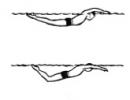Burbot fishing in December: where and when to catch burbot? Tricks and nuances of catching burbot in winter Catching burbot October December in open water
catching burbot open water
Fishing for burbot in open water
For several days, the first ice has become on small lakes and bays of reservoirs. The weather forecast is that the ice slowly builds up at night, and only rain can wash it away. The thickness of the ice is still critical and it is dangerous to go out on such ice and there is no point in taking risks. Therefore, most anglers continue to catch mainly predators in open water. In the daytime, pike and zander are well caught, and at night it is the turn of burbot. The burbot is now biting during the day, but at night it is better, and now it is almost the peak of its activity. Burbot is more active only in January, before spawning.
Burbot in cold water turns into an omnivorous predator, which becomes relatively easy to seduce with unpretentious baits of animal origin.
Some anglers' stories about successful autumn burbot fishing can mislead the beginner, who will have the illusion of ease of fishing. What could be easier than taking a piece of fishing line, tying a hook, load to it, throwing the hook with bait into the water, and in the morning pulling the tackle from the water to the shore and removing the burbot firmly sitting on the hook from the hook. If everything were so simple, then there would be no burbots.
In order to catch burbot in a pond, even where there is a lot of it, you need to choose the right place, and make the right tackle, even if it looks primitive at first glance, and choose the right bait and set the tackle correctly.
During autumn, it is more reliable to catch burbots on small rivers, such as Istra, Malaya Istra and on all tributaries of the Oka. First of all, you should find an area with a rocky or pebbly bottom. At night, burbots adhere to both sandbanks and rifts. It is almost impossible to meet this fish on a muddy bottom. Burbots always stick to the most oxygen-rich places.
Small burbots do not form flocks, but can live quite densely on good bottom areas. Large burbots roam the pond alone in autumn. Burbots choose their underwater paths and crawl from the shoal to a rocky or snarled hole, without making distant migrations. Long migrations are characteristic only in the pre-spawning period.
When choosing a fishing spot, remember that overnight stays small fish serve as sections of a reservoir where there is practically no current, if it is a river or stream, or places on the edge, close to coastal vegetation in stagnant reservoirs. That is, these are places in the area of the first coastal edge. Therefore, the colder the water becomes, the closer the burbots approach the shore at night. They leave the riverbed, deep pits and snags and go to shallows with a smooth course. Places with a smooth reverse flow are very good, especially on fast-flowing rivers, such as Malaya Istra.
Finding the habitat of burbots is possible only by trial and error. For example, you can cast several bottom rigs at different distances from the shore and at different depths (usually those who fish in large water bodies follow this tactic) and after a successful bite, all gear should be placed at the required distance from the shore. In autumn it is very interesting to catch burbots in numerous small tributaries of the Oka River. It is enough that the depth of such a river is only a meter. Places for the location of gear are selected on the border of the jet and small bays, directly under the very shore or below small islands, stones. Promising are the places where a river or stream flows into a larger river, namely, alluvial shallows at the junctions of the current. If the location of burbots is discovered, then you can visit it annually and be with a catch.
It is very rare in autumn to catch a second fish from one fishing point, but to catch it by shifting the tackle a little to the side is quite real.
The fishing time is chosen at night and you need to expect that you will have to spend the whole night fishing. It is very difficult to predict when the fish will approach the bait. But there are many cases when burbots were caught even during the day in clear sunny weather. If after one or two bites there is a lull, then there is no point in waiting for a long time, it is better to recast the equipment or to a different depth, or move them to the side. It has been noticed that burbot, like large pike, is better caught in weather when fish of other species prefer not to be active. That is, at a break in the weather, in the rain, during a strong wind. But with a full moon, on a clear, quiet night, most likely there will be no bites. Don't forget to take a flashlight and a knife with you.
Tackle for catching burbots are very simple equipment for bottom fishing with a bait lying on the bottom. If you are fishing on a large body of water, then take and design a dozen "snacks" based on fishing line with a diameter of 0.3-0.5 mm, with a sliding weight. Below the weight, a leash is tied from a fishing line with a diameter of 0.25-0.3 mm, at the end of which a single hook No. 1 is tied. There is no point in using double, and even more so, triple hooks. The burbot gradually swallows the bait very deeply and it is not easy to release it even from a single hook. But more importantly, the tee will contribute to the "dead" hooks of the tackle, because burbot fishing occurs either among stones, or snags and bottom irregularities. Therefore, the leashes are fastened through the clasp so that they can be easily and quickly replaced. For the same reason, you should not use prohibited in recreational fishing crossings and slips. For fishing at a small distance from the shore, a whip up to two meters long is convenient, to the end of which is attached bottom rigging on a line 2-5 meters long.
It is absolutely not necessary to watch burbot bites, although it is quite interesting. You can cast a bottom and check it every half hour: if a burbot bites, he will simply swallow the bait and wait to be pulled ashore. It must be said that during the pulling out, the burbot resists quite strongly and stubbornly, tends to hide in stones or catch its tail on some obstacle, so it is better not to use a line that is too thin.
If you want to keep an eye on possible bites, then the tip of a relatively "soft" rod should either be painted white, or a holder with a firefly attached to it. On small rivers it is very interesting to fish with a firefly float using the "half bottom" method.
The bite of a small burbot is very reminiscent of the ruff "twitching" of the mormyshka in winter or the summer bites of rotan. These are precisely the twitches that rarely develop into a classic pull. Often burbot throws the bait if it feels the resistance of a heavy sinker. The pull of a large burbot is clearly pronounced. I like to use my index finger as a bite signal, through which the fishing line is thrown. Not so boring.
As a bait for catching burbot in autumn, a small live bait is almost always used, impaled on a hook by the lip. I consider the ruff and minnow to be the best live bait, that is, those species of fish that lead a bottom lifestyle. The advice that the ruff should be cut off the spines or scraped off the scales seems to me not only inhumane, but also ineffective. Burbot prefers a live ruff that behaves naturally. A dead, and even more so a frozen fish, is likely to become a prey for crayfish, but if there is no other, then you have to use a dead live bait. The same applies to pieces of fish. Those anglers who prepare in advance for autumn fishing burbot, for the future are stocked with minnows and frogs during their wintering trip. Putting a frog on a hook is better for back foot to keep it alive and moving longer. A very good bait is a bunch of worms.
The tactics of catching burbot is based on the fact that it makes no sense to wait for the fish to approach, you need to look for it. If the first burbot is caught, then all the equipment should be transferred to places with a similar depth. In the event that the first fish was caught while entering the shallows, it is better to place the rigs along the area of the shallows or rocky ridge, since the next bite can occur at any point in the chosen place, and it is almost impossible to predict it. That is, the tactics of catching burbot is a continuous search and expectation. Echo sounders are not very helpful in the search, since the burbot does not swim, but practically crawls along the bottom with stops and it is very difficult to detect it. But with the help of an echo sounder, it is easy to find the hard and rocky bottom that this fish loves so much.
Burbot fishing continues successfully until ice formation, when burbot begins to "sick". Everyone knows that after the formation of ice, almost all types of fish fall into temporary apathy, and such species as chub, ide, and especially burbot are so hard on this period that they float up under the ice and stand clinging to it. There can be no talk of any cool at this time.
A. Yanshevsky
"Russian Hunting Newspaper No. 46 - 2005"
Attention!
An article from the site " Kaliningradsky fishing club
Winter time is a great time for burbot fishing, especially during this period burbot fishing in December stands out. December is notable for the fact that at the end of this month spawning begins at the burbot, and before it comes, the fish feeds especially actively, which plays into the hands of the angler. It is this period of winter time that is the time when burbot fats. Burbot is a very interesting and peculiar fish, very different in its behavior from other representatives of the underwater world.
Where is burbot kept
 Burbot prefers a solid rocky bottom, and even better if there is a spring nearby or two currents collide. The bottom, covered with a thick layer of silt, the fish avoids, because it is difficult to tolerate an environment poor in oxygen. Fishing for burbot in December, namely during the zhora, will be successful if you fish in shallow areas where there are coastal dumps, pre-channel platforms and the depth does not exceed 3 meters. As soon as the burbot starts spawning, the biting practically stops, only small burbots that have not reached puberty remain active.
Burbot prefers a solid rocky bottom, and even better if there is a spring nearby or two currents collide. The bottom, covered with a thick layer of silt, the fish avoids, because it is difficult to tolerate an environment poor in oxygen. Fishing for burbot in December, namely during the zhora, will be successful if you fish in shallow areas where there are coastal dumps, pre-channel platforms and the depth does not exceed 3 meters. As soon as the burbot starts spawning, the biting practically stops, only small burbots that have not reached puberty remain active.
When to catch burbot
Burbot flashing mainly occurs at night, so catching burbot in December is associated with certain inconveniences. In addition, the fish oh how loves rainy and especially frosty nights. But, what the angler will not endure, for the sake of the cherished bite.
 To catch burbot you will need a reliable and durable fishing rod, which will allow you to easily cope with weighty fish. The fishing line should be thick enough from 0.4 mm. In addition to everything, there must be a leash. After all, if you delay with hooking, the burbot can so swallow the bait offered during the flashing that it will be problematic to pull it out. Hooks are also used large, 12-14 number. Additional sinkers, you should not put, the spinner itself will be enough.
To catch burbot you will need a reliable and durable fishing rod, which will allow you to easily cope with weighty fish. The fishing line should be thick enough from 0.4 mm. In addition to everything, there must be a leash. After all, if you delay with hooking, the burbot can so swallow the bait offered during the flashing that it will be problematic to pull it out. Hooks are also used large, 12-14 number. Additional sinkers, you should not put, the spinner itself will be enough.
When luring, as soon as the first ice is established, many anglers prefer medium-sized silver-colored lures, which are usually used for zander fishing. The only addition that is made is to put pieces of fish on the tees, you can use bleak or a brush for this.
fishing technique
The technique of playing lure when catching burbot in December is as follows. After you arrived at the place, taking into account, of course, the preferences of burbot, we drilled a hole. Lower the lure to the very bottom and start lure, i.e. smoothly play with bait. Often success is brought by smooth movements up, down or obliquely. There is no need to complicate the game, this can negatively affect the reaction of the burbot itself. Also, do not lift the lure above half a meter from the bottom.
Most successful burbot bites generally occur at a distance of 0.1 to 0.3m from the bottom.
When flashing in a place where there is a ridge of large stones, good result V winter time brings the usual tapping of the spinner on the stones. I don’t know what attracts this burbot, but hitting a large stone or throwing a lure from a stone often ends in a bite.
Catching burbot (video)
Catching burbot in December is a very exciting activity, especially if lure is used to catch it. A bite when fishing with a lure is expressed in sharp and strong jerks of the fishing line. The undercut should be strong and sweeping. Do not think that you can pull the bait out of your mouth, this will not happen. After a successful hooking, at first the burbot practically does not resist, but you should not relax, approaching the hole, the fish will definitely put all its strength into its salvation. At this moment, the main thing is to hold the line and not let the burbot go to the bottom. The last meters are especially difficult when fighting, having great strength, the burbot begins to dodge in every possible way, preventing the angler from leading himself to the hole. In this case, a hook will not be superfluous on fishing, with which, if the burbot is successfully hooked, you can pull the burbot out of the hole without much difficulty.
No matter how difficult it is for the angler to catch burbot in December, this time remains the most catchy in the winter, giving a lot of pleasure to fans of this difficult, but very interesting fishing.

Burbot on ice
River without ice in winterSpinners continue to fish with tackle adapted for sub-zero temperatures. Do not lag behind them and lovers of fishing on the feeder, and float rod. Fishing at this time is mainly carried out from the shore, but it is also possible from a boat, because inflatable boat from PVC, are not afraid of frosts.
Equipment for fishing in the "off-season"
Despite the relative warmth, fishing in the cold season ( late autumn, in winter, or in early spring), has its own characteristics, which must be taken into account.
First of all, attention should be paid to equipment -. It should be warm and light, waterproof on the outside, and not trapping moisture on the inside.
Gear for fishing "in the cold"
rod, regardless of the method of fishing, maintain their working properties at a negative temperature.
fishing line on the coil must be treated with a composition that protects it from freezing.
It is well known that burbot begins to eat intensively, and, accordingly, to be caught, with the onset of cold weather, and is especially active in the pre-spawning period. And burbot spawns in January - February.
In winter, the traditional tackle for catching burbot from ice is girders. But what to do if there is no ice yet, and freezing is not expected?
The answer is in the next video:
Tricky tackle for catching burbot from the shore
In this way, you can fish well in the winter from the shore, and catch burbot on the bottom tackle.
Habits and habitats of burbot in December.
Burbot is considered a fish that is active in cold water, so burbot is more often caught in winter. But even in winter there is a certain period of time when burbot will not be caught, namely this is the spawning period.
Spawning of burbot usually begins in the middle, at the end of December and can last until mid-January, until early February.
Usually, about two weeks before spawning, pre-spawning zhor begins in burbot, when burbot actively roams the pond and does not refuse food. It can eat both fry and food that is strewn with the bottom, it can be a variety of bugs and crustaceans, as well as bloodworms and other larvae crawling along the bottom.
Burbot in December can be found both at depth and in shallow water near the coast. Usually in the daytime, burbot prefers to stay at a depth, often it will stand on the differences in depths, on the edges and coastal slopes.
But at night, in search of food, the burbot comes to the shore, to shallower depths, where it feeds on fry.
Always remember that burbot prefers a hard stone bottom or a clay bottom covered with silt.
Usually in December burbot is active during both day and night, but most of its activity will be observed at night.
If we talk about how the weather affects the bite of burbot in December, then we can say the following: "The worse the weather is for a person, the better the bite of burbot will be." Usually, in clear, slightly frosty weather, the burbot practically does not feed, but as soon as snowstorms or severe frosts begin, when it snows, the burbot becomes sharply activated and begins to feed.
Ways to catch burbot in December.
There are three most popular ways to catch burbot in December. This is catching burbot on burbots or stands, on a lure or a balancer, and on a method that works very well for burbot, this is catching burbot on a stalker.
And now in more detail about each of the presented methods.
Catching burbot in December on vents.
More often, this method is used for night fishing burbot in December, placing the vents in the evening and checking them in the morning.
The burbot vent is not much different from the pike vent, the main thing is that there is a strong and long fishing line, and the burbot themselves were of proper quality so that they were able to withstand the fight with burbot.
As a bait, you can use a fry fish, usually burbot prefers ruffs, but it also takes on a roach and minnow and perch, both live and dead fry can be hung on a hook. Burbot will be caught even on a piece of fish meat hung on a hook.
Catching burbot in December on baubles or a balancer.
This is a familiar method of fishing, in this way they catch both pike and zander, as well as other predators.
The main thing here is to have a strong fishing rod, and a strong fishing line. Because immediately after the bite, the burbot does not offer strong resistance, but as soon as you try to lead it through the hole, it will start to fight with all its might and the weak tackle simply cannot stand it.
For burbot, ordinary spinners and balancers are suitable, which can be used to catch the same pike.
Catching burbot on a stalker.
This method was invented specifically for catching burbot. The stoker itself is a voluminous heavy sinker, which is equipped with hooks, it can be either with one hook or with several.
The photo below shows stalkers for burbot.
For this method, you will need a fishing rod, but it must be tough, most fishermen do not bother at all, but take an ordinary branch 30 centimeters long, tie a fishing line on it and successfully catch burbot.
The fishing process is similar to the usual winter lure. You lift the bait with a wave of your hand, then sharply lower the rod and the bait falls to the bottom, when it falls, it makes a sound and raises turbidity and this attracts burbot.
On the hooks of the stalker, you can plant either a piece of fish meat or a dead fish.
Well, on this note, we will end our story.
Burbot is respected by most fishermen not only for the fact that catching it is interesting, but also for the delicious meat. Fish can be cooked in any form, but cutlets are especially famous. In addition, burbot does not have small bones, which is also important for lovers of fish dishes. However, this amazing fish is not found in every region, and in order to catch it, it is important to have some skills. Catching burbot in December is an exciting fishing that brings great pleasure!
The uniqueness of burbot
It is important to note that burbot attracts fishermen not only by the specifics of fishing, but also by the fact that such fishing is very interesting and requires the fisherman to observe important points:
- careful preparation of tools for fishing;
- knowledge of the habits of fish;
- special clothing.
 The last point is extremely significant, because burbot is caught only in the cold season. To make fishing a real pleasure rather than turned into a torment, the fisherman is simply obliged to dress appropriately.
The last point is extremely significant, because burbot is caught only in the cold season. To make fishing a real pleasure rather than turned into a torment, the fisherman is simply obliged to dress appropriately.
Preparing for fishing should be with the onset of winter. It is at the beginning of December that the pre-spawning zhor begins. Burbot is one of the few fish that spawns in December, which also introduces some specifics.
Catching process
If the fisherman thinks that he is completely ready to fish, he needs to take into account some questions that will be very useful and will certainly bring a great catch. First of all, you need to find out the burbot places. The following information is important here:
- for fish, rocky bottom is a favorite;
- can be caught in those places where there is a fast current;
- the existence of small springs also guarantees the presence of fish.
It's all about that burbot is extremely difficult to tolerate oxygen deficiency, so it is very important for a fisherman to study the area where fishing will take place and choose the best option. Depth selection features will also be useful. Unique fish changes depth depending on the periods:
- In early December, when the zhora period begins, the fish prefer shallow depths - no more than three meters.
- After spawning, which takes place from mid-December to early January (depending on the regions), the fish can go to a depth of more than three meters.
- During spawning, the fish are in shallow water.
It is December that is considered the most successful month for fishing, because the fish during this period are very active and are at shallow depths.
The influence of weather on biting
Anyone, even a novice fisherman, understands that the weather significantly affects the quality of fishing. Here plays a role Atmosphere pressure, to which fish are very sensitive, including cod. There are species that are more active in bad weather or vice versa. Considering burbot, you should pay attention to such nuances:

For fans of the use of girders, it is important to know that it is better to put them in the late evening, and to carry out the check in the morning. It would be useful to mention that in winter, under the same conditions, ruff and pike perch bite very well.
What gear to use
Burbot is caught by various methods, including bait and bait, but lure fishing is the most popular method. The fact is that this method is not only effective, but also reckless, and this is certainly important for a fisherman. To properly prepare for fishing, you must follow a few rules:
- Gear should be strong, because burbot can reach ten kilograms of weight. Suitable fishing line from 0.4 mm.
- Leashes should reach 10-15 cm.
- The hook should also be impressive - size 12-14 will do.
- Do not use additional weights. The spinner itself may well play their role. Important point- the baubles must be medium in size and silver in color.
Experienced fishermen use some tricks that increase the chances of being caught. The fact is that burbot smells great, so it’s very good to put a small ruff or bleak on the hook. Fishing for burbot in December in open water can only be successful if all the nuances are taken into account.
Rules and technique of flashing
In order for burbot fishing to be successful, it is necessary to master the technique of playing with a lure. Needless to say, these skills come with practice. . The main points are as follows:

Most fishermen who have considerable experience note that fishing in December is effective if you tap the lure on the stones. Burbot is attracted by all sorts of sounds, including the fall of the spinner.
Types of bites
 Lure fishing in December is very specific and requires considerable experience from the fisherman. The bite of burbot consists in a sharp jerk of the spinner. Fish should be hooked in a sweeping manner. After a successful hook, the fish actually does not resist, which often misleads inexperienced fishermen. The difficulty of playing the fish lies precisely in the last meters, when the burbot begins to show desperate resistance.
Lure fishing in December is very specific and requires considerable experience from the fisherman. The bite of burbot consists in a sharp jerk of the spinner. Fish should be hooked in a sweeping manner. After a successful hook, the fish actually does not resist, which often misleads inexperienced fishermen. The difficulty of playing the fish lies precisely in the last meters, when the burbot begins to show desperate resistance.
The fish has considerable strength, and the fisherman must be prepared for this by holding the line firmly. It often happens that burbot spends sharp jerks and attempts to go to the bottom almost near the hole itself. When the head of the prey appeared in the hole, it is important to immediately grab it by the gills. Burbot body is very slippery, and by another method it is simply impossible to pull it out.
There are nuances that beginner fishermen should consider:
- If it was not possible to pull out the prey the first time and the fish went straight out of the hole, it's okay. Here you should not rush, give the burbot the opportunity to go to the very bottom. Only after that you need to start a new process of fighting.
- If it turned out that the fish went into the hole with its tail, you need to use a hook, which should always be at hand.
- After the burbot is pulled out, you need to hit it on the ice or hit it on the stomach. After such a blow, the fish increases in volume, which is important for cod liver gourmets.
 Such, at first glance, simple recommendations are very important in practical use. It is quite natural that for experienced fishermen such actions are carried out automatically. As for beginners, it is absolutely important for them to remember these moments and strictly follow them when catching burbot in December.
Such, at first glance, simple recommendations are very important in practical use. It is quite natural that for experienced fishermen such actions are carried out automatically. As for beginners, it is absolutely important for them to remember these moments and strictly follow them when catching burbot in December.
Each fishing has its own nuances and specifics, but we can say with confidence that catching burbot in December is not an easy task, although it is extremely exciting. Not every beginner will be lucky enough to immediately get a solid trophy, but such fishing guarantees a huge amount of positive emotions.
By following the recommendations exactly, you can count on a decent catch and a good mood. However, do not forget that each reservoir has its own specifics. Going on a fishing trip, it would be very good to consult with experienced anglers. They are always willing to talk about their exploits and huge burbots, which they pulled out in time immemorial.






